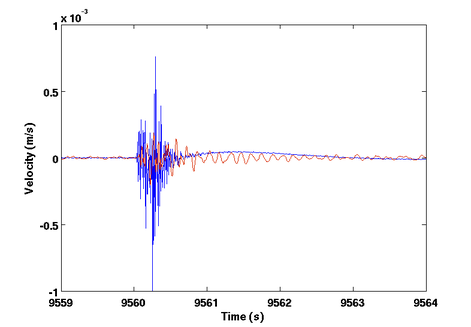Seismic Monitoring of the excavation blasts in the Leonhardstrasse construction site
Since late March the excavation works for the new ETH building in Leonhardstrasse include regular blasts (explosions), which are heard and felt in the surrounding buildings. The SED has installed 13 seismic sensors in the NO building to monitor the response to these blasts. NO houses the SED as well as the Department of Earth Sciences, and is located some 10’s of meters from the construction site. Nine sensors were placed in the northeastern edge of the building, one at each floor, and four sensors were distributed across the building in the B, F, H and J floors. The sensors continuously monitored the structure over a two week period. The objectives of the survey are to monitor the amplitude of the building motion and compare its dynamic behaviour at different amplitude levels. With these measurements, it is possible to characterize the response of the building to various different ground motions.
Preliminary analysis of the explosions indicate they induce noticeably higher velocity amplitude than do ambient vibrations. The measured maximum velocity at the basement of the building during a blast is typically 1 mm/s, whereas at the top of the building it is of the order of 0.5 mm/s. For comparison, under normal conditions (ambient motion) the velocity at the basement of the building is 0.003 mm/s and at the top 0.01 mm/s. Despite these high values the blast does not significantly excite the building resonance frequencies since the amplitudes at the roof are smaller than that recorded at the basement. The displacement of the top floor, obtained by integration of the velocity recordings, barely exceeds the ambient vibration amplitudes. The maximum inter-story drift is in the order of 10-7 m/m, whereas cracking typically appears only once this value exceeds 10-4 m/m (1000 times larger motions).
As determined from its response to ambient vibrations, the fundamental resonance frequencies of the structure are between 3 and 4 Hz. In contrast the blast produces energy above 20 Hz, which explains why it doesn’t excite the resonance frequencies of the building.
In conclusion, the blasting performed in the excavation work at Leonhardstrasse induces amplitudes in local buildings large enough to be felt. However, this blasting is not affecting the structural integrity of the NO building since it does not excite the building resonance frequencies.
The blasting will continue until September, and more recordings at NO are planned towards the end of this excavation. The data are stored in the SED archive and will be accessible to the community via the Arclink server (arclink.ethz.ch; Station Name: NOETH). This work is a collaboration between SED and the Institut für Baustatik und Konstruktion (IBK).
See also: Michel C., Guéguen P., Bard P.Y. “Dynamic parameters of structures extracted from ambient vibration: an aid for the seismic vulnerability assessment of existing buildings”, Soil Dynamics and Earthquake Engineering, 28(8), (593-604), August 2008.
Acknowledgements: This temporary network was installed by Franz Weber and Clotaire Michel. The SED archive is maintained by E-lab. The Arclink server to access the data was designed and maintained by Carlo Cauzzi.
